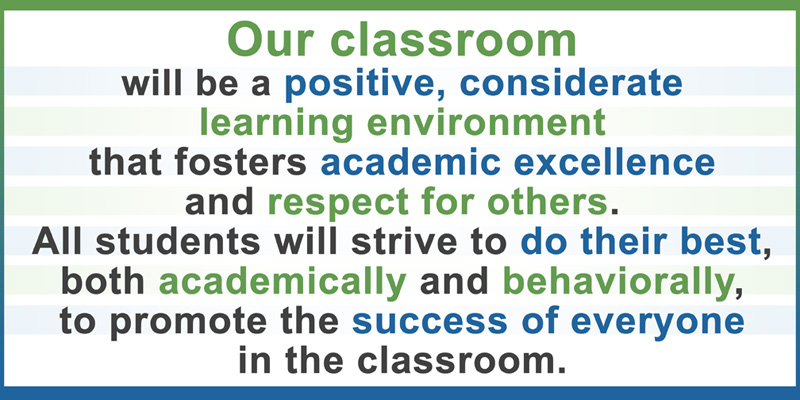How do teachers address the behavior issues of youth in these settings?
To create a safe and successful learning environment, all teachers, regardless of whether the school is using PBIS, need to create a comprehensive behavior management plan. This plan should clearly define behavioral expectations, procedures, and consequences. For those using PBIS, a comprehensive behavior management plan would constitute Tier 1 support and therefore be implemented with all students. By creating this plan, teachers can:
- Prevent many problem behaviors from occurring in the first place
- Minimize other disruptive behaviors
- Help students feel safe, both physically and emotionally (e.g., safe from ridicule and teasing), something that better enables them to learn
The five components of a comprehensive classroom behavior management plan are described below.
Statement of Purpose
A brief, positive statement that conveys to students the reasons why various aspects of the management plan are necessary. It should be focused, direct, clearly understandable, and free of specialized jargon. Below is a sample statement of purpose.
 be a positive, considerate learning environment that fosters academic excellence and respect for others. All students will strive to do their best, both academically and behaviorally, to promote the success of everyone in the classroom." width="507" height="254" />
be a positive, considerate learning environment that fosters academic excellence and respect for others. All students will strive to do their best, both academically and behaviorally, to promote the success of everyone in the classroom." width="507" height="254" />
Rules
Rules are explicit statements of how the teacher expects students to behave in his or her classroom. Rules provide a way for students to monitor their own behavior, and they remind and motivate students to display the behaviors that are expected of them. In cases where there is a school-wide behavior management system in place, teachers should create classroom rules that align with the school’s existing rules. In addition, teachers should limit the number of classroom rules to five or fewer and make certain that those rules adhere to the guidelines outlined in the table below.
| Guidelines for Developing Rules |
| State positively | Example: Follow directions the first time they are given.
Nonexample: Do not argue when asked to do something. |
| Use simple, specific terms | Example: Talk in a whisper when working with a partner.
Nonexample: Maintain a reasonable vocal level when working with a peer. |
| Make measurable and observable | Example: Go straight to your seat when you enter the classroom.
Nonexample: Come to the classroom ready to work. |
| Ensure that they convey expected behavior | Example: Keep your hands to yourself.
Nonexample: Be a good citizen. |
Rules should be explicitly taught and practiced until all students understand them. Teachers should regularly and consistently recognize students when they follow the rules.
Procedures
Sample Procedure
Walking in the Hallway
- Single file
- Hands behind backs
- Straight line
- Silent
- Stop at checkpoints
Procedures are a description of the steps required for students to understand what is expected of them to successfully or correctly complete daily activities. Procedures can be developed:
- So that routines in the classroom (e.g., how to ask a question, how to turn in assignments) happen efficiently and without incident
- To prevent problems in situations where students are more likely to exhibit disruptive or inappropriate behavior (e.g., transitions, unstructured time)
Procedures should be explicitly taught and practiced until all students thoroughly understand what is expected of them. Correct execution of the procedure should be recognized, and problem areas should be immediately corrected. In addition, teachers should reinforce students with regularity and consistency to ensure that they continue to perform the procedure correctly over time.
Consequences

Consequences are actions teachers take to respond to both appropriate and inappropriate student behaviors. After a student follows a rule or procedure, his or her teacher can provide a positive consequence. A positive consequence, often referred to as reinforcement, is a means by which teachers can increase the probability that a behavior will occur in the future. Positive consequences should be:
- Something the student considers pleasant or rewarding
- Inexpensive
- Appropriate to the juvenile justice environment
- Easily and quickly administered or awarded
When a student violates a rule or procedure, a teacher can provide a negative consequence. A negative consequence is a means by which the teacher can decrease the probability that a behavior will occur in the future. Most appropriate negative consequences in JC facilities should involve lack of access to preferred activities. When they are administered, negative consequences should be:
- Applied immediately after the behavior occurs
- Considerate of a student’s dignity
- Applied in an educative rather than vindictive fashion (i.e., when a student engages in negative behaviors, a teacher should not take it personally or respond emotionally)
- Administered calmly and consistently
- Used in conjunction with positive consequences
- Logical and related to the undesirable behavior (e.g., if the student misbehaves during recreational time, the negative consequence might be a loss of future recreational time)
Action Plan
An action plan guides the teacher as he or she implements a comprehensive behavior management plan. Typically, an action plan includes goals to be accomplished (e.g., teach the behavior plan to the students), the tasks or steps to be completed in order to achieve each goal (e.g., create classroom rules), and a completion date.
This toolbox lists and describes additional resources related to the information presented on this page. These resources are provided for informational purposes only for those who wish to learn more about the topic(s). It is not necessary for those viewing this module to read or refer to all of these additional resources to understand the content.
- Classroom Behavior Management (Part 1): Key Concepts and Foundational Practices
This module highlights the importance of establishing a comprehensive classroom behavior management system composed of a statement of purpose, rules, procedures, consequences, and an action plan. It also provides information about how culture, classroom factors, and teacher actions can influence student behavior (est. completion time: 1 hour).
- Classroom Behavior Management (Part 2, Secondary): Developing a Behavior Management Plan
This module reviews the major components of classroom management (including rules, procedures, and consequences) and guides users through the steps of creating their own comprehensive behavior plan. The module is a companion to Classroom Behavior Management (Part 1): Key Concepts and Foundational Practices (est. completion time: 2 hours).
- Addressing Disruptive and Noncompliant Behaviors (Part 1): Understanding the Acting-Out Cycle
The first in a two-part series, this module discusses problem behavior in terms of the stages of the acting-out cycle and suggests ways to respond to students in the cycle’s different phases (est. completion time: 1 hour).

 be a positive, considerate learning environment that fosters academic excellence and respect for others. All students will strive to do their best, both academically and behaviorally, to promote the success of everyone in the classroom." width="507" height="254" />
be a positive, considerate learning environment that fosters academic excellence and respect for others. All students will strive to do their best, both academically and behaviorally, to promote the success of everyone in the classroom." width="507" height="254" />